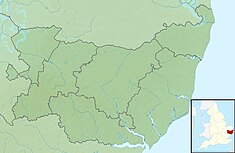| Somerleyton Hall | |
|---|---|
 The garden front | |
| Type | Country house |
| Location | Somerleyton, Suffolk |
| Coordinates | 52°31′15″N 1°40′23″E / 52.5207°N 1.6731°E |
| Built | 1844 |
| Architect | John Thomas |
| Architectural style(s) | Jacobethan |
| Owner | Sir Samuel Morton Peto |
Listed Building – Grade II* | |
| Official name | Somerleyton Hall |
| Designated | 29 January 1987 |
| Reference no. | 1198046 |
Listed Building – Grade II* | |
| Official name | Stable Court to Somerleyton Hall |
| Designated | 29 January 1987 |
| Reference no. | 1352646 |
Listed Building – Grade II* | |
| Official name | Kitchen Garden of Somerleyton Hall |
| Designated | 29 January 1987 |
| Reference no. | 1031936 |
Listed Building – Grade II | |
| Official name | Remains of Winter Garden of Somerleyton Hall |
| Designated | 29 January 1987 |
| Reference no. | 1031930 |
| Official name | Somerleyton Park |
| Designated | 29 January 1987 |
| Reference no. | 1000188 |
Somerleyton Hall is a country house and 5,000-acre (2,000 ha) estate near Somerleyton and Lowestoft in Suffolk, England owned and lived in by Hugh Crossley, 4th Baron Somerleyton, originally designed by John Thomas. The hall is Grade II* listed on the National Heritage List for England, and its landscaped park and formal gardens are also Grade II* listed on the Register of Historic Parks and Gardens. The formal gardens cover 12 acres (4.9 ha). Inspired by Knepp Wildland, Somerleyton is rewilding 1,000 acres (400 ha) of the estate to which he has introduced free-roaming cattle, large black pigs and Exmoor ponies.
